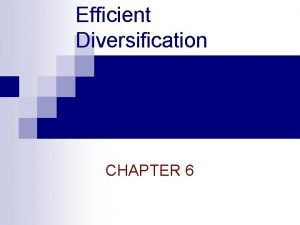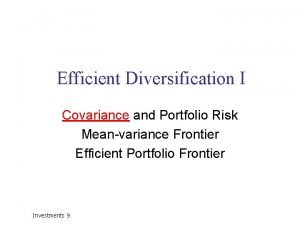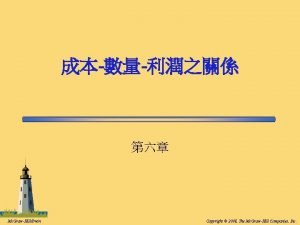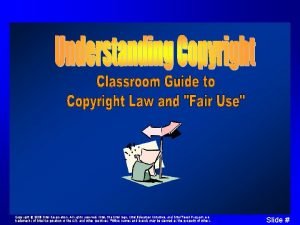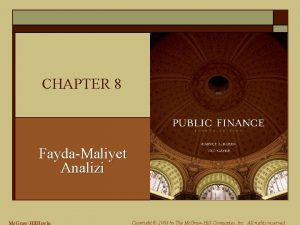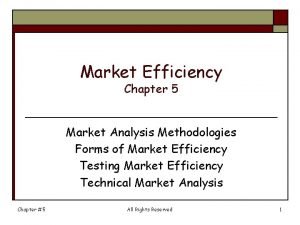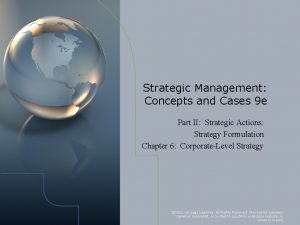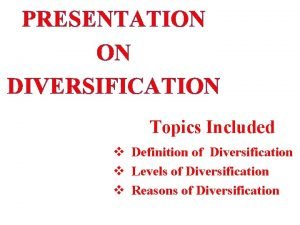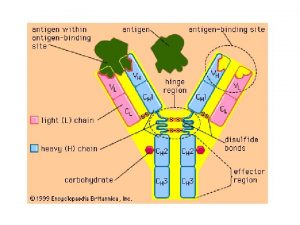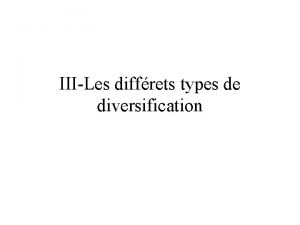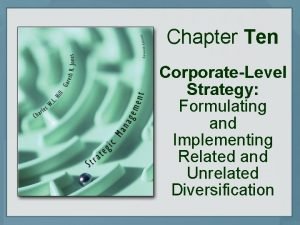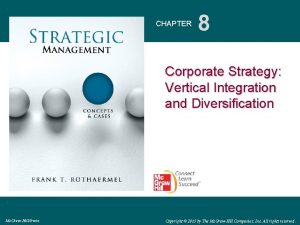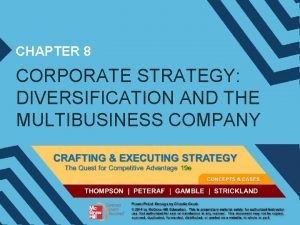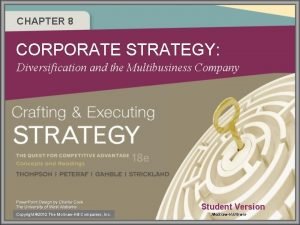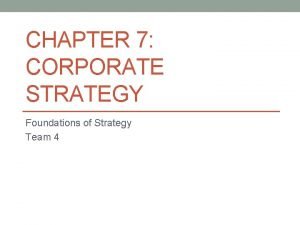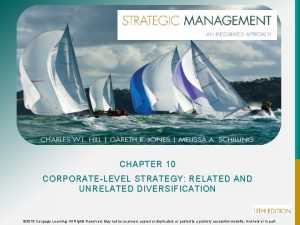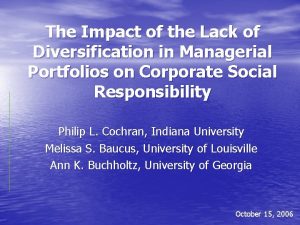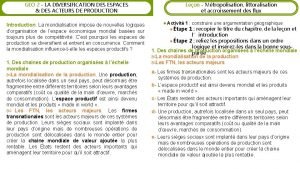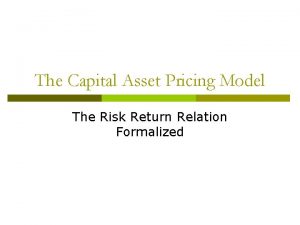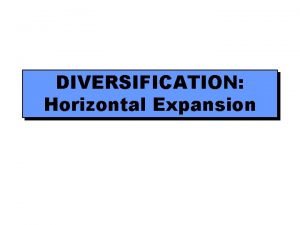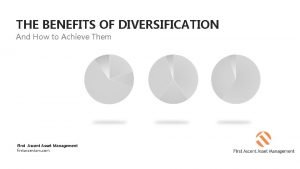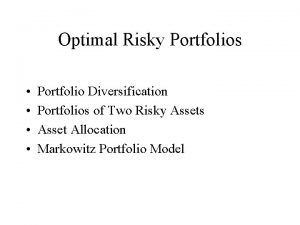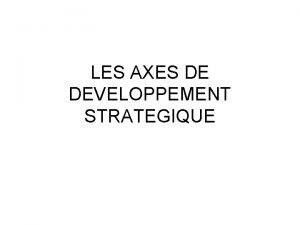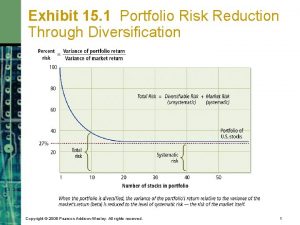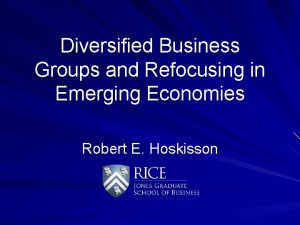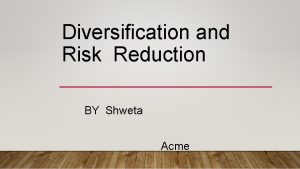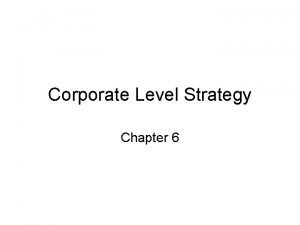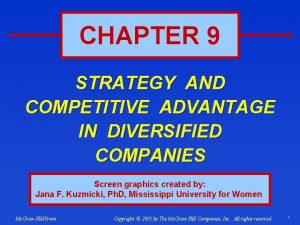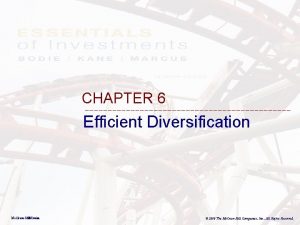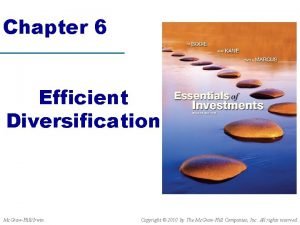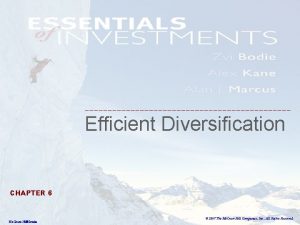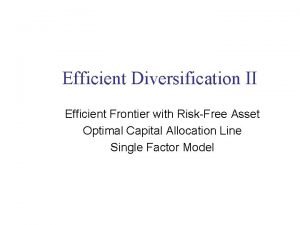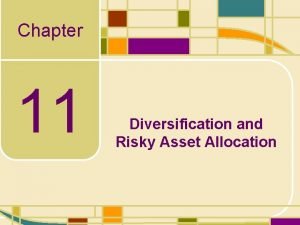CHAPTER 6 Efficient Diversification Mc GrawHillIrwin Copyright 2008












































- Slides: 44

CHAPTER 6 Efficient Diversification Mc. Graw-Hill/Irwin Copyright © 2008 The Mc. Graw-Hill Companies, Inc. , All Rights Reserved.

6. 1 DIVERSIFICATION AND PORTFOLIO RISK 6 -2

Diversification and Portfolio Risk Market risk – Systematic or Nondiversifiable Firm-specific risk – Diversifiable or nonsystematic 6 -3

Figure 6. 1 Portfolio Risk as a Function of the Number of Stocks 6 -4

Figure 6. 2 Portfolio Risk as a Function of Number of Securities 6 -5

6. 2 ASSET ALLOCATION WITH TWO RISKY ASSETS 6 -6

Covariance and Correlation Portfolio risk depends on the correlation between the returns of the assets in the portfolio Covariance and the correlation coefficient provide a measure of the returns on two assets to vary 6 -7

Two Asset Portfolio Return – Stock and Bond 6 -8

Covariance and Correlation Coefficient Covariance: Correlation Coefficient: 6 -9

Correlation Coefficients: Possible Values Range of values for r 1, 2 -1. 0 < r < 1. 0 If r = 1. 0, the securities would be perfectly positively correlated If r = - 1. 0, the securities would be perfectly negatively correlated 6 -10

Two Asset Portfolio St Dev – Stock and Bond 6 -11

In General, For an n-Security Portfolio: rp = Weighted average of the n securities sp 2 = (Consider all pair-wise covariance measures) 6 -12

Three Rules of Two-Risky-Asset Portfolios Rate of return on the portfolio: Expected rate of return on the portfolio: 6 -13

Three Rules of Two-Risky-Asset Portfolios Variance of the rate of return on the portfolio: 6 -14

Numerical Text Example: Bond and Stock Returns (Page 169) Returns Bond = 6% Stock = 10% Standard Deviation Bond = 12% Stock = 25% Weights Bond =. 5 Stock =. 5 Correlation Coefficient (Bonds and Stock) = 0 6 -15

Numerical Text Example: Bond and Stock Returns (Page 169) Return = 8%. 5(6) +. 5 (10) Standard Deviation = 13. 87% [(. 5)2 (12)2 + (. 5)2 (25)2 + … 2 (. 5) (12) (25) (0)] ½ [192. 25] ½ = 13. 87 6 -16

Figure 6. 3 Investment Opportunity Set for Stocks and Bonds 6 -17

Figure 6. 4 Investment Opportunity Set for Stocks and Bonds with Various Correlations 6 -18

6. 3 THE OPTIMAL RISKY PORTFOLIO WITH A RISK-FREE ASSET 6 -19

Extending to Include Riskless Asset The optimal combination becomes linear A single combination of risky and riskless assets will dominate 6 -20

Figure 6. 5 Opportunity Set Using Stocks and Bonds and Two Capital Allocation Lines 6 -21

Dominant CAL with a Risk-Free Investment (F) CAL(O) dominates other lines -- it has the best risk/return or the largest slope Slope = 6 -22

Dominant CAL with a Risk-Free Investment (F) Regardless of risk preferences, combinations of O & F dominate 6 -23

Figure 6. 6 Optimal Capital Allocation Line for Bonds, Stocks and T-Bills 6 -24

Figure 6. 7 The Complete Portfolio 6 -25

Figure 6. 8 The Complete Portfolio – Solution to the Asset Allocation Problem 6 -26

6. 4 EFFICIENT DIVERSIFICATION WITH MANY RISKY ASSETS 6 -27

Extending Concepts to All Securities The optimal combinations result in lowest level of risk for a given return The optimal trade-off is described as the efficient frontier These portfolios are dominant 6 -28

Figure 6. 9 Portfolios Constructed from Three Stocks A, B and C 6 -29

Figure 6. 10 The Efficient Frontier of Risky Assets and Individual Assets 6 -30

6. 5 A SINGLE-FACTOR ASSET MARKET 6 -31

Single Factor Model βi = index of a securities’ particular return to the factor M = unanticipated movement commonly related to security returns Ei = unexpected event relevant only to this security Assumption: a broad market index like the S&P 500 is the common factor 6 -32

Specification of a Single-Index Model of Security Returns Use the S&P 500 as a market proxy Excess return can now be stated as: – This specifies the both market and firm risk 6 -33

Figure 6. 11 Scatter Diagram for Dell 6 -34

Figure 6. 12 Various Scatter Diagrams 6 -35

Components of Risk Market or systematic risk: risk related to the macro economic factor or market index Unsystematic or firm specific risk: risk not related to the macro factor or market index Total risk = Systematic + Unsystematic 6 -36

Measuring Components of Risk si 2 = bi 2 sm 2 + s 2(ei) where; si 2 = total variance bi 2 sm 2 = systematic variance s 2(ei) = unsystematic variance 6 -37

Examining Percentage of Variance Total Risk = Systematic Risk + Unsystematic Risk Systematic Risk/Total Risk = r 2 ß i 2 s m 2 / s 2 = r 2 bi 2 sm 2 / bi 2 sm 2 + s 2(ei) = r 2 6 -38

Advantages of the Single Index Model Reduces the number of inputs for diversification Easier for security analysts to specialize 6 -39

6. 6 RISK OF LONG-TERM INVESTMENTS 6 -40

Are Stock Returns Less Risky in the Long Run? Consider a 2 -year investment Variance of the 2 -year return is double of that of the one -year return and σ is higher by a multiple of the square root of 2 6 -41

Are Stock Returns Less Risky in the Long Run? Generalizing to an investment horizon of n years and then annualizing: 6 -42

The Fly in the ‘Time Diversification’ Ointment Annualized standard deviation is only appropriate for short-term portfolios Variance grows linearly with the number of years Standard deviation grows in proportion to 6 -43

The Fly in the ‘Time Diversification’ Ointment To compare investments in two different time periods: – Risk of the total (end of horizon) rate of return – Accounts for magnitudes and probabilities 6 -44
 What is efficient diversification
What is efficient diversification Gmvp meaning
Gmvp meaning Productively efficient vs allocatively efficient
Productively efficient vs allocatively efficient Productively efficient vs allocatively efficient
Productively efficient vs allocatively efficient C b a d
C b a d Allocative efficiency vs productive efficiency
Allocative efficiency vs productive efficiency Allocative efficiency vs productive efficiency
Allocative efficiency vs productive efficiency 2008 2008
2008 2008 Copyright 2008
Copyright 2008 Copyright 2008
Copyright 2008 Copyright 2008
Copyright 2008 Copyright 2008
Copyright 2008 2008 pearson prentice hall inc
2008 pearson prentice hall inc Copyright 2008
Copyright 2008 Copyright 2008
Copyright 2008 Efficient chapter 5
Efficient chapter 5 Related and unrelated diversification
Related and unrelated diversification What is related constrained diversification
What is related constrained diversification What is related constrained diversification
What is related constrained diversification Antibody diversification
Antibody diversification Diversification de confortement
Diversification de confortement Diversification types
Diversification types Forward integration and backward integration
Forward integration and backward integration Make or buy continuum
Make or buy continuum A strategy of diversifying into unrelated businesses
A strategy of diversifying into unrelated businesses A diversified company has a parenting advantage when it
A diversified company has a parenting advantage when it Related and unrelated diversification
Related and unrelated diversification Intensive integrative and diversification growth strategies
Intensive integrative and diversification growth strategies Unrelated diversification companies
Unrelated diversification companies Lack of diversification
Lack of diversification Intensive integrative and diversification growth strategies
Intensive integrative and diversification growth strategies Diversification of samsung
Diversification of samsung Diversification des espaces et des acteurs de la production
Diversification des espaces et des acteurs de la production Market risk premium
Market risk premium Diversification de confortement
Diversification de confortement Three dimensions of corporate strategy
Three dimensions of corporate strategy Attributes of m-commerce
Attributes of m-commerce Benefits of diversification
Benefits of diversification Optimal risky portfolio with 3 assets
Optimal risky portfolio with 3 assets Diversification concentrique
Diversification concentrique Risk reduction through diversification
Risk reduction through diversification Samsung unrelated diversification strategy
Samsung unrelated diversification strategy Risk reduction through diversification
Risk reduction through diversification Reasons for diversification
Reasons for diversification Retrenching to a narrower diversification base
Retrenching to a narrower diversification base
